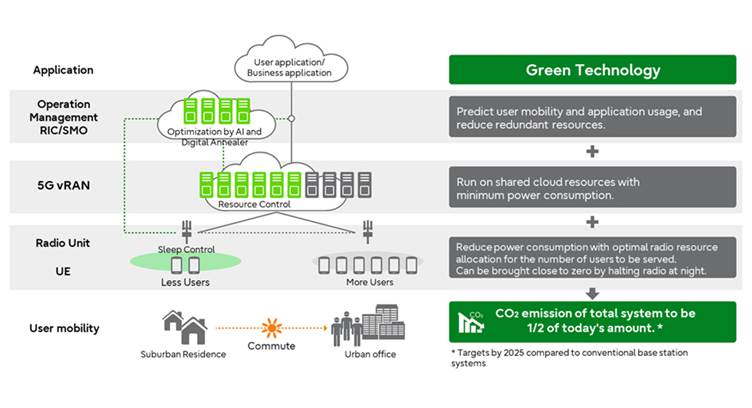Fujitsu this week announced that it has successfully developed new software virtualized radio access network (vRAN) technology with support for 5G Standalone (SA) and will offer it for verification by telecommunications carriers from March 2022.
By leveraging Fujitsu’s AI and quantum-inspired “Digital Annealer” technologies to optimize computing resources, the newly developed vRAN technology addresses one of the key challenges of conventional vRANs, delivering high-performance with low-energy consumption. Fujitsu estimates that this approach offers the potential to reduce overall system CO2 emissions by 50% or more compared to conventional base station systems by 2025, while offering users high-quality, stable communications.
Moving forward, Fujitsu plans to deploy this vRAN technology globally, offering robust and innovative support to telecommunications carriers working to reduce their carbon footprint, and ultimately contribute to the realization of a more sustainable society.
In recent years, advances including performance improvements in general-purpose CPUs and the virtualization of wireless signal processing and control technology (telecom function) have opened an exciting wide range of new possibilities for technological innovation in communications, including the appearance of vRAN technology. The introduction of vRANs composed of general-purpose servers, which don’t require the costly development of specialized hardware, is currently drawing attention as an attractive alternative to conventional base stations.
Despite their promise, existing vRAN technology continues to face barriers to wider adoption. For instance, vRANs that are not configured with dedicated equipment tend to have lower performance efficiency than conventional base stations. To maintain the same performance, more hardware must be built in, resulting in higher environmental loads in areas like power consumption. In terms of stability and redundancy, there have also been cases in which conventional vRANs cannot sufficiently guarantee carrier-grade communication quality.
Fujitsu’s new vRAN technology supports 5G SA and conforms to O-RAN specifications, while leveraging the following proprietary technologies to successfully solve some of the challenges surrounding conventional vRANs. By optimizing the entire 5G wireless network and reducing the amount of equipment and power consumption, Fujitsu’s vRAN offers the potential to contribute to significant reductions in the total CO2 emissions throughout carriers’ 5G wireless systems.
In March 2022, Fujitsu will begin providing software that runs on general-purpose servers for carrier verification, and will support various types of verification, including field testing. By the end of fiscal 2022, Fujitsu plans to start offering this technology as a service on a global basis, with the aim of expanding it to the commercial service networks of each carrier. Its goal is to reduce total CO2 emissions by 50% or more by 2025, compared to conventional base station systems, by successively updating software functions and further improving technologies to reduce environmental impact.




















